The Colosseum: Where Ancient Roars Still Echo Through Time
Standing at the heart of Rome for nearly 2,000 years, the Colosseum isn’t just a monument—it’s a living portal to the visceral pulse of the ancient world. This iconic amphitheater, where the roars of 50,000 spectators once shook the air, now welcomes over 7 million visitors annually, making it the world’s most visited archaeological site. But what transforms a crumbling stone oval into an eternal symbol? It’s the way history here grips your senses: the worn grooves of gladiators’ footsteps still visible on the arena floor, the faint scent of travertine stone warming under the Italian sun, and the haunting acoustics that make whispers bounce off arches where emperors once decreed life or death.
A Stage for Glory and Grief
Built in 80 AD under Emperor Titus, the Colosseum was Rome’s ultimate cross between a sports arena and a sacred space. For 450 years, it hosted gladiator duels, naval battles (yes, they flooded it!), and exotic animal hunts—but also public executions and mythological reenactments that blurred entertainment and ritual. Today, as you run your fingers over the pockmarked walls, you’re touching the same stones that:

- Commodus personally fought on (though historians suspect his opponents were given wooden swords)
- Early Christian martyrs faced lions before weeping crowds
- Medieval families converted into makeshift homes during plagues
The genius of its 80 arched entrances (vomitoria) still shines—modern stadium designers copy this system to move crowds efficiently.
Why the Colosseum Captivates
What makes this ruin #1 on 93% of Rome itineraries isn’t just its size (it could fit two football fields), but its raw humanity:
- The Underground (Hypogeum): Recently opened tunnels reveal ancient elevators that launched tigers and gladiators into the arena
- Graffiti Alley: Faded carvings of gladiator stats (“Crescens beat 12 opponents!”) show ancient fantasy sports fandom
- Moonlight Magic: Night tours let you stand where prisoners awaited fate, bathed in the same silver light that calmed lions
Locals have a saying: “When the Colosseum falls, Rome falls—then the world.” After surviving 4 earthquakes, a medieval quarry phase (its marble clad St. Peter’s Basilica!), and WWII bombs, its defiant stance moves visitors to tears.
The Colosseum’s Birth: A Political Masterstroke That Became Eternal
When Emperor Vespasian ordered construction of the Colosseum in 72 AD, it wasn’t just about entertainment—it was a brilliant political reset. After Nero’s extravagant reign left Rome bankrupt and resentful, Vespasian chose the site of Nero’s private lake for this public arena, literally burying the old regime’s excesses under communal joy. Funded by treasures looted from Jerusalem’s destroyed temple (a fact carved into the Arch of Titus), the Flavian Amphitheater—as it was originally known—rose at breakneck speed. 60,000 Jewish slaves quarried travertine from Tivoli, transporting 100,000 cubic meters of stone along a specially built road (Via Tiburtina) that still exists today. When Titus inaugurated it in 80 AD with 100 days of games, the message was clear: Rome’s new emperors would share wealth (and bloodshed) with the people.
Visitors today unknowingly retrace ancient paths:
- The imperial entrance (Gate of Life) where emperors entered still bears chariot grooves
- Seat numbers etched into marble reveal the strict social hierarchy—senators up front, women and slaves in the nosebleed “bleachers”
- The hypogeum’s 80 winch systems, recently restored, show how slaves staged “special effects” like sudden tiger appearances
Touch the walls near the third tier—the warmer patches mark where lead pipes once circulated hot water for winter events.
Beyond Gladiators: The Colosseum as Ancient Rome’s Beating Heart
While Hollywood focuses on gladiator duels, the Colosseum’s spectacles were multi-sensory propaganda. Morning venationes (animal hunts) showcased Rome’s global reach—North African lions, Caspian tigers, and even Indian rhinos fought to the death. At lunchtime, public executions of criminals reenacted myths (like Icarus’ fall with wax wings). Then came the *main event: gladiators—often celebrities with fan clubs—battling under strict rules (referees oversaw bouts). But the most astonishing shows were naumachiae: the arena flooded with 1.5 million gallons of water (from a dedicated aqueduct) for naval battles recreating Salamis or Actium.
Modern visitors can still feel this legacy:
- The wooden arena floor, now partially reconstructed, vibrates when stomped—just as it did for roaring crowds
- Graffiti in the corridors depicts gladiator stats like a sports almanac (“Flamma: 21 wins, 4 losses!”)
- The cross in the arena marks where early Christians likely perished, now strewn with flowers from pilgrims
Architectural Wonder: The Colosseum – Eternal Echoes of Roman Innovation
Known in antiquity as the Flavian Amphitheatre, the Colosseum stands as a breathtaking reminder of Rome’s architectural and engineering genius. Construction began around 70 AD, commissioned by Emperor Vespasian, and was finalized during the reign of his son, Titus, a decade later. This vast arena was purpose-built for thrilling public spectacles—gladiator duels, exotic beast hunts, and even simulated naval skirmishes were staged to entertain thousands. Its grand scale, thoughtful layout, and innovative structure highlight the Romans’ unmatched skill in building venues that blended utility with awe-inspiring design.
Designed to seat over 50,000 spectators, the Colosseum was a masterpiece of crowd management and structural precision. Its elliptical layout ensured unobstructed views from every seat, while the tiered seating arrangement echoed the rigid social hierarchy of Roman society — emperors and senators sat closest to the action, while the commoners and women occupied the upper levels.
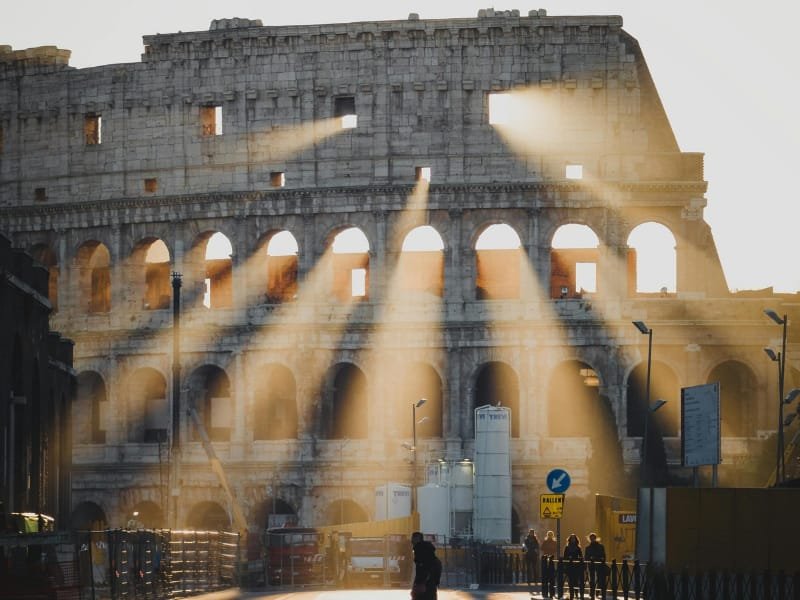
Crafted from travertine limestone, volcanic tuff, and brick-faced concrete, the Colosseum was built to endure. These materials, along with Rome’s advanced construction techniques, helped the structure withstand earthquakes, fires, and centuries of weathering.
Hidden beneath the arena was the hypogeum — a complex underground network of tunnels, chambers, and elevators. This innovation allowed for dramatic entrances of gladiators and wild animals through trapdoors, intensifying the thrill for spectators above. Roman engineers also pioneered efficient crowd flow with 80 arched entrances known as vomitoria, which enabled the massive audience to enter and exit swiftly — a concept that continues to influence modern stadium architecture.
Another marvel was the velarium, a massive retractable awning that shaded the audience from the sun — further proof of Roman attention to comfort and design.
Today, as millions walk through its weathered arches, the Colosseum remains more than a ruin. It is a living monument to ancient Rome’s architectural genius, a cultural icon that continues to shape how we design public spaces in the modern world.
Innovations in Roman Engineering and Crowd Control: The Legacy of the Colosseum
The Colosseum wasn’t just a venue for entertainment—it was a revolutionary feat of engineering that set new standards in construction and public safety. Roman architects employed advanced techniques to ensure stability, including the use of concrete (a Roman invention) for the foundations, which provided flexibility against seismic activity. The outer façade featured three tiers of arches adorned with Doric, Ionic, and Corinthian columns, blending aesthetics with structural integrity. The hypogeum’s pulley and elevator system, powered by slaves and animals, allowed for dynamic performances, creating an immersive experience for spectators. This underground network was so efficient that it could stage elaborate battle reenactments and wild beast hunts with seamless precision.
The Colosseum set the gold standard for managing large crowds long before the modern stadium was ever imagined. Ingeniously designed vomitoria—arched exit corridors—enabled over 50,000 spectators to leave the venue swiftly and safely, a technique that still inspires contemporary arena designs. Spectators were assigned specific sections through numbered stone tickets, reducing confusion and directing foot traffic with remarkable efficiency. Roman guards were strategically positioned throughout the amphitheatre to maintain order, ensuring events ran smoothly. To shield attendees from the harsh sun, a massive velarium—a retractable fabric canopy—was maneuvered by experienced sailors, offering shade and a touch of luxury.

Walking through the Colosseum today, one can almost hear the echo of ancient cheers and the rumble of history. With over 7 million visitors each year, this UNESCO World Heritage site remains not just a ruin, but a living symbol of Rome’s enduring impact on architecture, engineering, and public spectacle. Its innovative blueprint continues to shape how we build and experience grand arenas around the world.
Cultural and Social Significance: The Colosseum as the Heart of Roman Society
The Colosseum was far more than just an arena—it was the epicenter of ancient Roman culture, politics, and social life. In a society where public spectacles were a tool of governance, the games held within its walls served multiple purposes: they entertained the masses, reinforced imperial authority, and distracted citizens from political unrest. Emperors like Vespasian and Titus used the Colosseum as a propaganda machine, hosting free events to gain public favor. Gladiatorial combats, exotic animal hunts, and mock naval battles (naumachiae) were not merely bloodsport but carefully orchestrated displays of Rome’s dominance over nature and conquered nations. The crowds, sometimes exceeding 50,000 people, were a microcosm of Roman society—patricians, plebeians, slaves, and foreigners all gathered in a shared, albeit hierarchical, experience. The seating arrangement mirrored Rome’s rigid class structure, with the elite enjoying front-row marble seats while the lower classes stood in the upper tiers.
Beyond its political role, the Colosseum was a cultural melting pot where Romans from all walks of life bonded over collective excitement, horror, and awe. The games were so ingrained in daily life that workers had holidays on event days, and vendors thrived selling food, souvenirs, and even betting slips. The arena also served as a stage for social messaging—executions of criminals and Christians were public spectacles meant to deter dissent. Yet, amid the brutality, the Colosseum fostered a sense of community, where the roar of the crowd united citizens under the banner of Roman identity. Today, visitors walking through its ruins can almost hear the echoes of ancient cheers, feeling the weight of history in every stone. The Colosseum’s legacy endures not just as a monument of engineering but as a testament to how entertainment, power, and society intertwined in the Roman world.
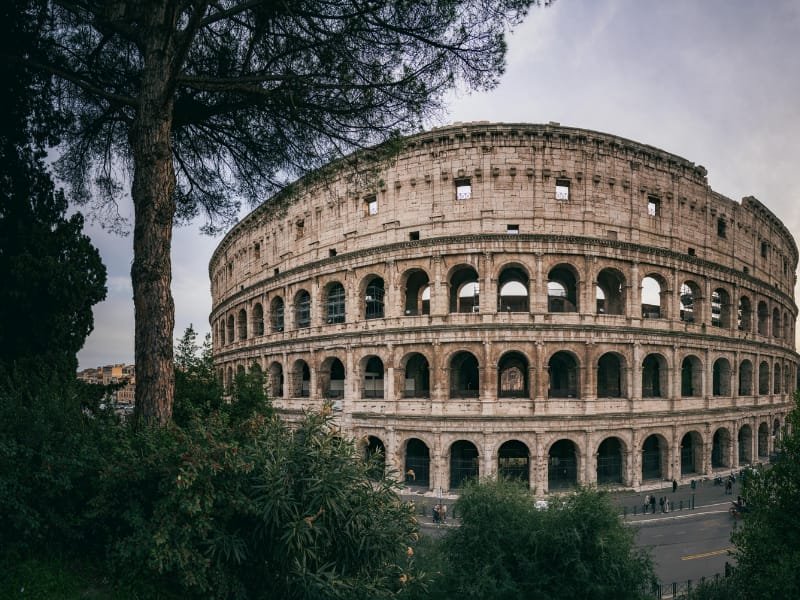
Symbol of Roman Power and Spectacle: The Colosseum’s Enduring Legacy
The Colosseum was the ultimate symbol of Rome’s imperial might, a physical manifestation of the empire’s wealth, ambition, and technological superiority. Its sheer scale—standing 160 feet tall with a footprint of six acres—was a deliberate statement: Rome could bend nature and human labor to its will. The materials used, from imported marble to Egyptian obelisks, showcased the empire’s vast reach, while the hypogeum’s machinery demonstrated unmatched engineering prowess. The games themselves were displays of dominance—exotic animals like lions, elephants, and giraffes were brought from Africa and Asia, proving Rome’s global influence. Even the gladiators, often slaves or prisoners of war, symbolized conquered peoples forced to fight for Roman amusement.
The Colosseum was never just an entertainment venue—it was a grand stage where emperors demonstrated their might and influence. Inaugural celebrations stretched over a hundred days, filled with relentless action aimed at astonishing the masses and reinforcing loyalty to the throne. Through lavish displays of “bread and circuses” (panem et circenses), Roman rulers kept the public content and distracted, solidifying their grip on power.
Even centuries later, the Colosseum’s legacy remains unshaken. It continues to inspire everything from modern stadium architecture to cultural phenomena like the film Gladiator. Visitors from across the globe come not only to witness its architectural brilliance but to immerse themselves in the pulse of ancient Rome. Standing beneath its colossal arches, one can almost hear the distant roars of the crowd and the clash of gladiatorial steel. The Colosseum is far more than an ancient relic—it’s a living emblem of ambition, spectacle, and the enduring spirit of an empire that once ruled the known world.
Destruction and Neglect: The Colosseum’s Turbulent Journey Through Time
The Colosseum, once the crown jewel of ancient Rome, endured centuries of devastation, surviving not just the fall of an empire but also the ravages of time, natural disasters, and human exploitation. Major earthquakes in 443 AD, 508 AD, and 1349 caused significant structural damage, collapsing entire sections of the outer ring and leaving the southern side permanently weakened. As Rome’s political and economic power waned, the amphitheater fell into neglect, repurposed as a fortress, a quarry, and even a makeshift housing complex during the medieval period. The most destructive phase came when its limestone and marble were systematically looted for building materials—stones were stripped to construct palaces, churches (including St. Peter’s Basilica), and Renaissance-era monuments. This plundering left gaping holes in the Colosseum’s façade, a stark contrast to its original grandeur.
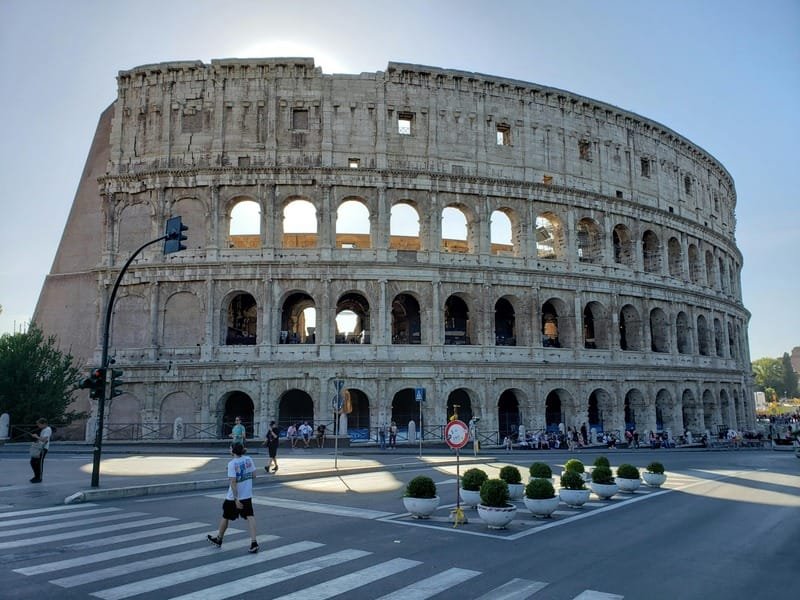
Despite its decay, the Colosseum never faded from public consciousness. During the 18th and 19th centuries, a growing fascination with antiquity spurred early preservation efforts. Pope Benedict XIV declared the site sacred in 1749, halting further stone theft and consecrating it as a Christian martyr’s memorial—though historical evidence for large-scale Christian executions there remains debated. Archaeologists and architects began stabilizing the ruins, reinforcing crumbling arches and removing invasive vegetation that threatened its foundations. Yet, it wasn’t until the late 20th century that comprehensive restoration projects, funded by Italy and international organizations, addressed centuries of erosion and pollution damage. Today, visitors can still see the scars of its turbulent past, from earthquake fractures to missing tiers, but these imperfections only deepen its historical resonance.
Restoration and UNESCO Recognition: Safeguarding an Icon for Future Generations
The Colosseum’s modern revival began in earnest in the 1990s, when advanced engineering techniques were deployed to combat pollution-induced decay and structural instability. A multi-phase restoration campaign cleaned centuries of grime from the travertine façade, revealing inscriptions and decorative details long hidden beneath blackened layers. Cutting-edge monitoring systems were installed to track seismic activity and weathering, ensuring proactive preservation. Perhaps the most ambitious project was the 2010s restoration of the hypogeum, where collapsing underground tunnels were reinforced with titanium supports, allowing visitors to finally walk through the gladiators’ hidden world. These efforts, funded in part by ticket sales and private donors, transformed the site from a crumbling relic into a meticulously conserved monument.
In 1980, the Colosseum earned UNESCO World Heritage status as part of the “Historic Centre of Rome,” a testament to its universal cultural value. This designation not only bolstered conservation funding but also cemented its role as a global symbol of human achievement. UNESCO’s involvement has helped balance tourism demands with preservation—limiting daily visitor numbers and implementing sustainable lighting to reduce environmental stress. Night tours, inaugurated in recent years, offer a magical perspective, with the illuminated arches casting shadows that evoke the arena’s ancient spectacles. For today’s visitors, the Colosseum is no longer just a ruin but a living classroom, where interactive exhibits and augmented reality reconstructions bridge the gap between past and present. As climate change and mass tourism pose new challenges, ongoing innovations ensure that this architectural marvel will endure, inspiring awe for centuries to come. Standing beneath its moonlit arches, one can almost hear the ghosts of gladiators and emperors whispering—proof that some legends never die.
Essential Visitor Guide: Timings, Tickets & Tips for Exploring the Colosseum
Planning a trip to the Colosseum? Here’s what you need to know before you go. The ancient amphitheater welcomes visitors every day, generally from 8:30 AM to 7:00 PM, with the last admission allowed at 6:00 PM. In the winter months, hours may be slightly reduced, so always double-check before your visit. For a more relaxed experience, aim to arrive early in the morning or after 4 PM—midday crowds between 11 AM and 3 PM tend to be the heaviest, especially during peak season.
Standard entry tickets are €18 for adults, with an additional €2 online reservation fee. EU citizens under 18 can enter for free, while those aged 18–25 can enjoy discounted rates. To save time and skip long queues, it’s highly recommended to book a “skip-the-line” ticket through the official CoopCulture site or trusted platforms like GetYourGuide. Travelers planning to explore multiple Roman landmarks should consider the Roma Pass (€32 for 48 hours or €52 for 72 hours), which includes Colosseum entry and unlimited access to public transport.
The most enjoyable times to visit are during spring (April to June) and autumn (September to October), when the weather is mild and crowds are thinner. Visiting in winter also has its perks—fewer tourists and a moody Roman atmosphere—though note that some sections like the hypogeum may close during poor weather.
Getting there is easy: Colosseo Metro Station (Line B) places you just a few steps from the entrance. You can also take bus routes #75, #81, or tram #3. And before you enter, don’t forget to snap a photo at the Arch of Constantine—standing proudly next to the Colosseum, it offers a stunning glimpse into Rome’s imperial past.
Unmissable Colosseum Experiences: Arena Access, Underground Labyrinth, and Sky-High Views
To truly appreciate the grandeur and historical depth of the Colosseum, opting for a special guided tour is highly recommended. One of the most exciting features is Arena Floor access, where you can step onto the very stage where gladiators once faced their fates, surrounded by the towering structure that once held nearly 50,000 spectators. These premium tours usually begin at €24, offering an unforgettable, close-up encounter with ancient history.
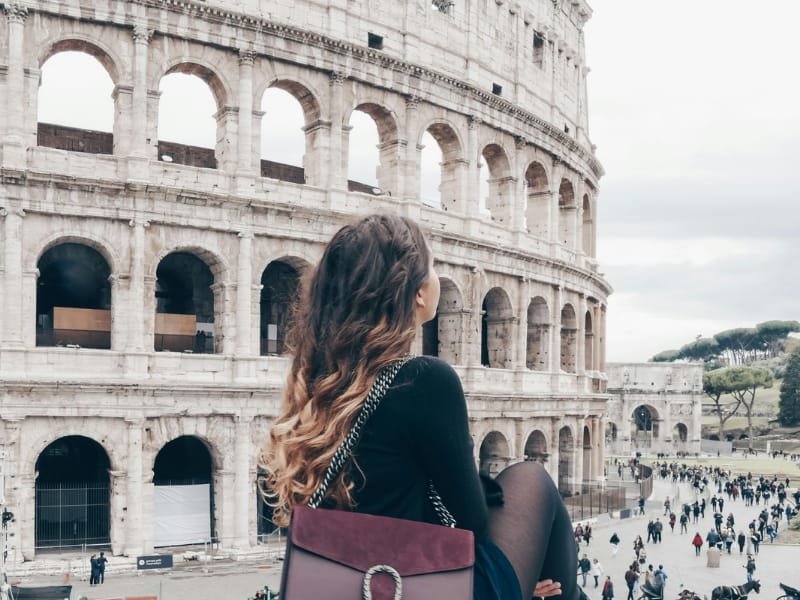
If you’re a history buff, don’t miss the chance to explore the Hypogeum, the underground area beneath the arena. This hidden network of tunnels and chambers was once bustling with activity—from preparing wild animals for combat to organizing performers and equipment. Since spaces are limited, it’s smart to book your tour well in advance, with prices ranging from €22 to €35 depending on the provider and package details.
For those who love scenic perspectives, tours to the upper levels, especially the fifth tier (Belvedere), provide panoramic views across Rome and a unique perspective of the amphitheater’s massive structure. These are only available through select tour operators and must be reserved early due to their limited availability.
If you’re exploring on a budget, a self-paced audio tour is a fantastic option—usually available for around €6. These tours allow you to wander through the Colosseum while listening to detailed historical narration, giving you the freedom to explore at your own rhythm. For a more immersive experience, however, guided tours led by expert storytellers can make the history come alive, often weaving together gripping tales of emperors, gladiators, and epic events that once filled this legendary arena.
Families visiting with children will find interactive, kid-friendly tours especially engaging, often featuring games, quizzes, and captivating tales suited for younger minds. For those planning to explore more, a combined ticket covering the Colosseum, Roman Forum, and Palatine Hill (about €24) is ideal. These sites are all close together, and a single pass makes for a convenient and cost-effective day of ancient Roman discovery.
Night Tours and Special Access: The Colosseum After Dark
When the crowds fade, the Colosseum transforms under moonlight. Night tours (April–October, €25–€50) offer a hauntingly beautiful perspective, with spotlit arches and access to typically closed areas like the underground. The cooler evening air and dramatic lighting make this a photographer’s dream. Some tours include exclusive access to the gladiator’s gate (Porta Libitinaria), where fallen fighters were carried out.
For history buffs, VIP small-group tours (€80–€150) provide after-hours entry with archaeologists—perfect for soaking in the atmosphere without jostling. Check the CoopCulture website for seasonal specials, like summer concerts in the arena.
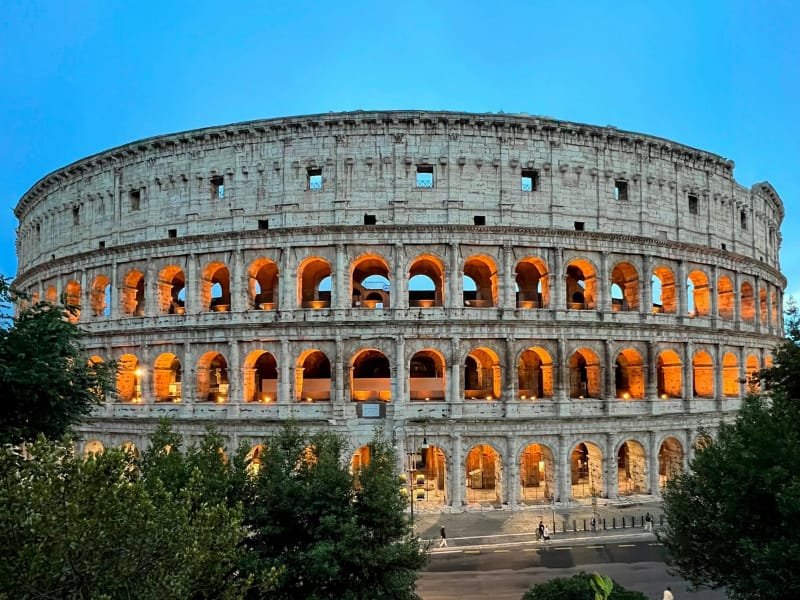
Nearby Attractions and Pro Tips for a Seamless Visit
Extend your ancient Rome immersion with a stroll through the Roman Forum (included in your ticket)—the crumbling heart of the empire, where senators once debated. The Palatine Hill offers leafy walks and imperial palace ruins with sweeping city views. Combo tickets covering all three sites are valid for 24–48 hours.
Visitor tips: Wear comfortable shoes (uneven stones abound) and bring water/sunscreen—shade is scarce. Large bags aren’t allowed, but small backpacks (under 30x30x15 cm) are permitted. For a post-tour treat, grab gelato at Gelateria dei Gracchi (10 mins walk) or dine with a Colosseum view at Ristorante Aroma (splurge-worthy rooftop).
With smart planning, your Colosseum visit will be unforgettable walking in the footsteps of gladiators and emperors in the world’s most legendary arena. Book ahead, arrive early, and let history come alive!
Photography & Travel Tips: Capturing the Perfect Colosseum Shot
The Colosseum is a photographer’s dream, but capturing its grandeur requires strategy. For the best exterior shots, arrive at sunrise when golden light bathes the ancient stones and crowds are thin—the eastern side (near Via dei Fori Imperiali) offers iconic frontal views with dramatic shadows. At sunset, position yourself on Palatine Hill for a breathtaking silhouette against fiery skies. Inside, the upper tiers provide sweeping perspectives of the arena floor and hypogeum; wide-angle lenses (16-35mm) work best to emphasize the scale. For unique angles, shoot through the archways to frame the structure or focus on details like weathered carvings and stairwells.
To avoid crowds, visit on weekdays (Tuesday–Thursday) and book the first entry slot (8:30 AM). Midday brings harsh lighting and tour groups, so use this time to explore shaded areas like the underground chambers. For crowd-free interior shots, linger near closing time when most visitors have left.
Pro tip: A polarizing filter reduces glare on sunny days, while a tripod (allowed with prior permission) helps with low-light shots. Nearby, the Arch of Constantine (just outside) makes a perfect foreground element for wide compositions.
For hassle-free planning, book skip-the-line tickets and tours in advance via GetYourGuide or Tiqets. Stay at nearby hotels like Hotel Palazzo Manfredi (booking link: Booking.com) for rooftop views of the Colosseum illuminated at night.
Nearby Attractions: Roman Forum & Palatine Hill – A Journey Through Ancient Rome
Your Colosseum ticket includes access to the Roman Forum and Palatine Hill, two sprawling archaeological sites that were the political and social hubs of ancient Rome. The Forum, a short walk west of the Colosseum, features ruins of temples (like the Temple of Saturn), basilicas, and the Via Sacra (Sacred Way), where triumphal processions marched. Don’t miss the House of the Vestal Virgins or Julius Caesar’s memorial. For panoramic views, climb Palatine Hill, where emperors built lavish palaces like Domus Flavia. The Farnese Gardens offer a serene escape with sweeping vistas of the Forum and Circus Maximus.
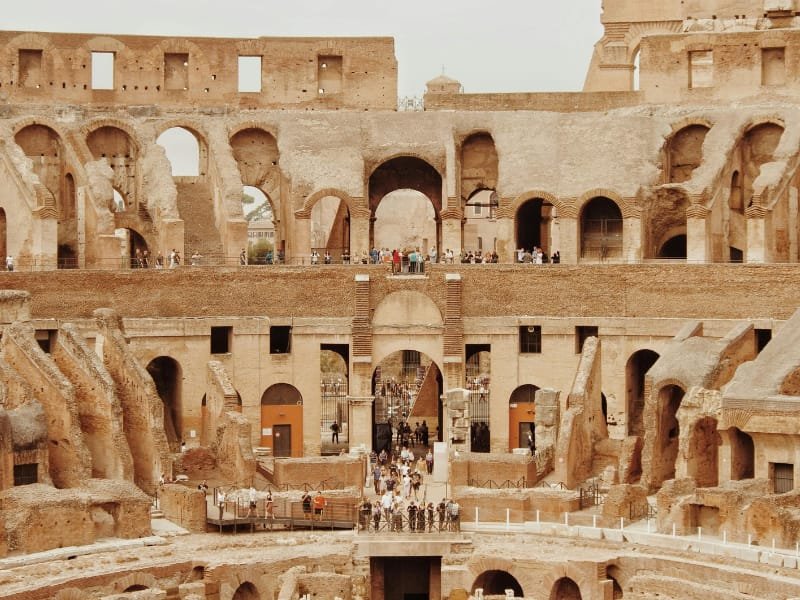
Guided tours (book via CoopCulture) bring these ruins to life with stories of political intrigue and daily Roman life. Combo tickets (€24) cover all three sites and are valid for 24 hours. Visit early or late to avoid crowds—the Forum’s Arch of Titus and Temple of Antoninus and Faustina are particularly photogenic in soft light.
Hidden Gems & Practical Tips for Exploring Rome’s Ancient Heart
Beyond the main sites, lesser-known spots offer quieter moments. The Bocca della Verità (Mouth of Truth), a 10-minute walk south, is a fun photo op (legend says it bites liars!). The Basilica di San Clemente layers 2,000 years of history, from a 1st-century Mithraeum to a 12th-century church. For a break, Oppio Caffè near the Colosseum serves espresso with a view.
Transport tip: The Colosseo Metro stop (Line B) is closest, but Cavour (Line B) is less crowded. Wear sturdy shoes—uneven terrain abounds. End your day with a stroll along Via dei Fori Imperiali, lit magically at night. For curated stays, book a historic B&B like Nerva Boutique Hotel (Booking.com) near the Forum.
Colosseum FAQs: Your Essential Visitor’s Guide
1. Is the Colosseum worth visiting?
Absolutely! The Colosseum isn’t just a pile of ancient stones—it’s a 2,000-year-old stage of gladiators, emperors, and epic battles. Walking through its arches feels like stepping into a movie (literally, if you’ve seen Gladiator). Plus, your ticket includes the Roman Forum and Palatine Hill, making it a triple-threat historical experience.
2. How long does it take to explore?
Plan for 1.5–2 hours for the Colosseum alone. Add 2+ hours if exploring the Roman Forum and Palatine Hill. Guided tours (highly recommended!) often run 3 hours for all three sites.
3. Are night tours safe and recommended?
Yes! Night tours are safer and more magical than daytime visits—fewer crowds, cooler temps, and dramatic lighting. Official tours have security staff. Book via CoopCulture for legit options.
4. Can I visit the underground chambers?
Only on special guided tours (book months ahead!). The hypogeum (where gladiators waited) is the most fascinating part—worth every euro. Check for last-minute cancellations!
5. What’s the best time to visit to avoid crowds?
- First entry (8:30 AM) for empty photos.
- Weekdays (Tue–Thu) are quieter.
- November–February (but some areas may close).
6. Are skip-the-line tickets necessary?
100% yes. Regular lines can be 2+ hours long. Book skip-the-line tickets on GetYourGuide or the official site.
7. Is it wheelchair accessible?
Partially. The ground floor and first tier are accessible, but the upper levels/underground are not. Elevators are available—request assistance at entry.
8. Can I bring a backpack inside?
Small bags (under 30x30x15 cm) are allowed. Larger bags must be checked (free, but lines form fast).
9. Where’s the best photo spot?
- Outside: Via dei Fori Imperiali (front view) or Metro Colosseo exit (side angle).
- Inside: Upper tiers for arena panoramas.
- Sunset: Palatine Hill for golden-hour magic.
10. What’s nearby to pair with my visit?
- Roman Forum & Palatine Hill (included in ticket).
- Arch of Constantine (free, right outside).
- Bocca della Verità (10-min walk—stick your hand in the “Mouth of Truth”!).
Pro tip: Wear comfy shoes—those ancient stones are uneven!
(Need a hotel with a Colosseum view? Check Booking.com for rooftop stays!) 😊
The Colosseum’s Enduring Legacy: Why the World Still Marvels
For nearly 2,000 years, the Colosseum has stood as more than just an ancient ruin—it’s a powerful symbol of human ambition, ingenuity, and the universal love of spectacle. This iconic amphitheater wasn’t just the stage for gladiator battles and imperial propaganda; it was a revolutionary feat of engineering that still influences modern stadium design today. From its hypogeum’s trapdoor systems (the ancient equivalent of special effects) to its 80 arched entrances that allowed 50,000+ spectators to flood in and out with ease, the Colosseum was Rome’s ultimate crowd-pleaser. But its legacy goes beyond architecture—it represents the heartbeat of Roman culture, where social classes collided, emperors manipulated public opinion, and the roar of the crowd echoed through history.
Even in the modern age, the Colosseum remains a breathtaking destination that draws travelers eager to step back in time. Wandering its ancient walkways and standing beneath its weathered arches, one can almost sense the echoes of history—the cheers, the tension, the spectacle of centuries past. Far more than a crumbling ruin, this monument offers a vivid glimpse into the heart of Roman civilization. Whether your interest lies in grand architecture, epic stories of emperors and warriors, or simply discovering iconic landmarks, the Colosseum never fails to inspire. With new areas—like the long-hidden gladiator chambers—now open to the public thanks to ongoing restoration efforts, each visit brings fresh insight into this enduring symbol of human ambition and cultural legacy.
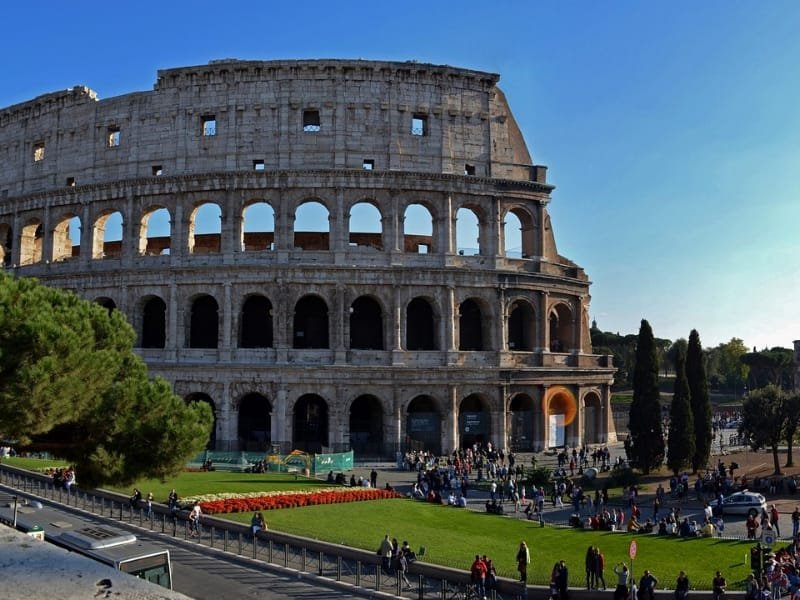
Now it’s your turn to stand where emperors and gladiators once stood. Whether you’re planning your first visit or dreaming of a return trip, the Colosseum never loses its magic. Book a night tour to see its arches glow under moonlight, or splurge on an underground tour to explore its hidden depths. Pair it with the Roman Forum and Palatine Hill for the full ancient Rome immersion—your ticket covers all three!
Don’t just read about history—live it. Skip the lines with a priority ticket, stay at a nearby hotel with a view (like Hotel Palazzo Manfredi), and make your visit unforgettable. The Colosseum has waited 2,000 years for you… are you ready to answer its call? 🏛✨
(Pro tip: Tag your photos with #ColosseumMoments—we’d love to see your adventure!)
